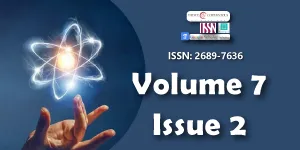The Nature of the Physics of Matter with Negative Mass
Main Article Content
Abstract
The formation of a substance with negative mass (negamatter) at very high temperatures or body speeds above 235696.8871 km/s is theoretically justified. The reason for this is the reversal of the direction of time inside the substance. The law of dependence of body weight on the rate of time passing in the physical body has been derived. Based on the weakness of gravitational forces, the stability of negamatter is justified, under appropriate conditions.
Downloads
Article Details
Copyright (c) 2024 Golovkin BG.

This work is licensed under a Creative Commons Attribution 4.0 International License.
Licensing and protecting the author rights is the central aim and core of the publishing business. Peertechz dedicates itself in making it easier for people to share and build upon the work of others while maintaining consistency with the rules of copyright. Peertechz licensing terms are formulated to facilitate reuse of the manuscripts published in journals to take maximum advantage of Open Access publication and for the purpose of disseminating knowledge.
We support 'libre' open access, which defines Open Access in true terms as free of charge online access along with usage rights. The usage rights are granted through the use of specific Creative Commons license.
Peertechz accomplice with- [CC BY 4.0]
Explanation
'CC' stands for Creative Commons license. 'BY' symbolizes that users have provided attribution to the creator that the published manuscripts can be used or shared. This license allows for redistribution, commercial and non-commercial, as long as it is passed along unchanged and in whole, with credit to the author.
Please take in notification that Creative Commons user licenses are non-revocable. We recommend authors to check if their funding body requires a specific license.
With this license, the authors are allowed that after publishing with Peertechz, they can share their research by posting a free draft copy of their article to any repository or website.
'CC BY' license observance:
|
License Name |
Permission to read and download |
Permission to display in a repository |
Permission to translate |
Commercial uses of manuscript |
|
CC BY 4.0 |
Yes |
Yes |
Yes |
Yes |
The authors please note that Creative Commons license is focused on making creative works available for discovery and reuse. Creative Commons licenses provide an alternative to standard copyrights, allowing authors to specify ways that their works can be used without having to grant permission for each individual request. Others who want to reserve all of their rights under copyright law should not use CC licenses.
Golovkin BG. Newton's Second Law in Special Theory of Relativity. J Phys Opt Sci. 2022;4(5):1-5. doi:10.47363/JPSOS/2022(4)173. Available from: https://doi.org/10.47363/JPSOS/2022(4)173.
Golovkin BG. A substance with negative mass. Ann Math Phys. 2023;6(2):119-125. Available from: https://dx.doi.org/10.17352/amp.000091.
Golovkin BG. High-temperature negative mass plasma. Ann Math Phys. 2024;7(1):118-137. Available from: https://dx.doi.org/10.17352/amp.000115.
Golovkin BG. The speed of the body at the moment of transition to a massless state is a new world constant. Ann Math Phys. 2023;6(2):114-118. Available from: https://dx.doi.org/10.17352/amp.000090.
Spiridonov OP. Fundamental physical constants. "Highest school". Moscow; 1991. 238.
Corbalan F. The Golden Ratio. The Beautiful Language of Mathematics. Deagostini; 2010.
Arakelyan GB. Mathematics and history of the golden section. Moscow: Logos; 2014; 404.
Terletsky YP. Materials of the VII All-Union Conference “Modern theoretical and experimental problems of the theory of relativity and gravitation.” Yerevan; 1988;457.
Terletsky YP. Negative Masses and the Energy-Sources of the Universe. Exp Technic Phys. 1981;29(4):331-332. Available from: https://www.osti.gov/etdeweb/biblio/5728864.
Ishlinsky AY. Classical mechanics and inertial forces. Moscow: Lenand; 2018; 44-48.
Lobanovsky MG. Foundations of natural physics. Moscow: "Higher School"; 1990; 264.
Buchholz NN. Basic course in theoretical mechanics. Part 1. Moscow: "Science"; 1977;398-400.
Atsukovsky VA. General ether dynamics. Moscow: Energoatomizdat; 2008; 584; Atsukovsky VA. General Ether-Dynamics. Simulation of the Matter Structures and Fields based on the Ideas about the Gas-Like Ether. Moscow: Energoatomizdat. 1990;197.
Nikolaev SA. Evolutionary circulation of matter in the universe. St. Petersburg: Polytechnic University; 2007; 304.
Bronstein MP. On spontaneous decay of photons. Physics of the Soviet Union. 1936;10:686-688.
Bronstein MP. On the possibility of spontaneous splitting of photons. In: Einstein's collection. 1980-1981. Moscow: Science. JETP. 1937;7:335-356.1985; 283-290.
Zeldovich YA, Novikov ID. Is the explanation of the redshift unambiguous by the expansion of the Universe? In: The structure and evolution of the Universe. Moscow: Science; 1975;123-125.
Golovkin BG. Proof of Einstein`s postulates. Ann Math Phis. 2022;5(1):13-20. Available from: https://doi.org/10.17352/amp.000035.
Golovkin BG. New Particle Mechanics with Negative Mass. World Scientific News. 2019;126:283-320. Available from: https://worldscientificnews.com/new-particle-mechanics-with-negative-mass/.
Golovkin BG. Physical meaning temperature of gas and separate molecule. World Scientific News. 2018;94:313-320. Available from: https://www.researchgate.net/publication/323308881_Physical_meaning_temperature_of_gas_and_separate_molecule.
Golovkin BG. Distribution of gas molecules by their temperatures. Appl Phys Math. 2019;(6):27-31. Available from: https://bibliotekanauki.pl/articles/1030475.pdf.
Whitrow GJ. The Natural Philosophy of Time. Edinburgh: Thomas Nelson and Edinburg; 1961. Gale RM. [Review of The Natural Philosophy of Time; Time and the Physical World, by G. J. Whitrow & R. Schlegel]. Philos Phenomenol Res. 1962;23(2):279–281. Available from: https://doi.org/10.2307/2104923.

